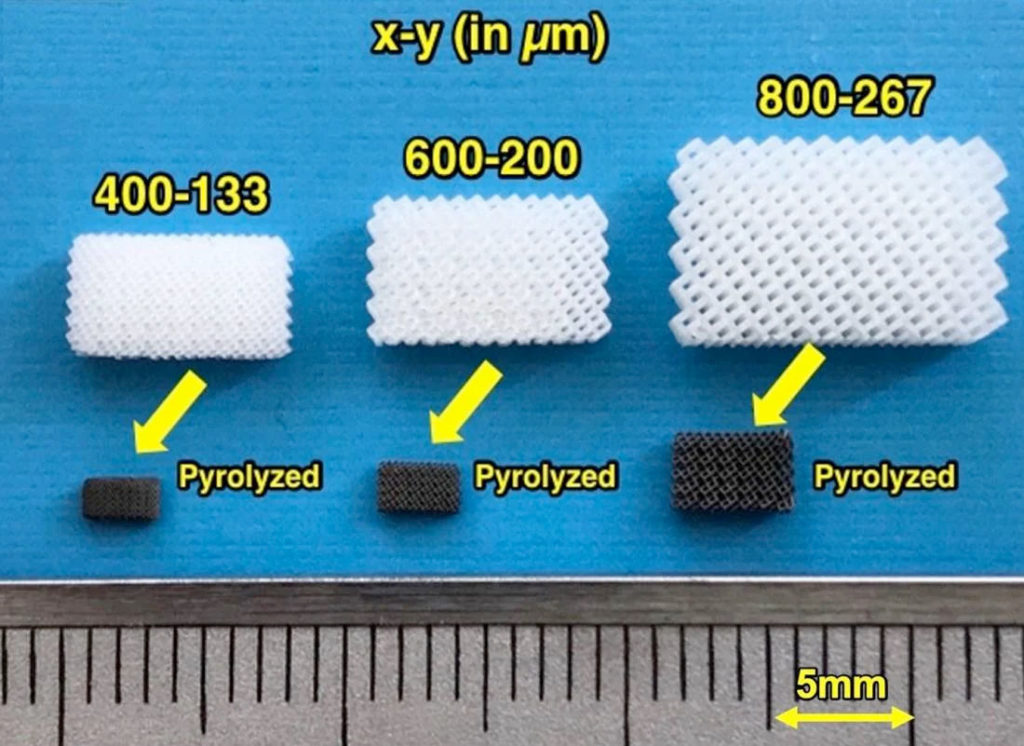Now that additive manufacturing (AM) is being applied to an increasing number of energy applications, the technology has truly begun demonstrating the potential for revolutionizing the efficiency of power generation. One particular application is in the 3D printing of battery parts, which could yield better, yet cheaper lithium-ion batteries. The latest development in this space comes from researchers at Tohoku University, who 3D printed carbon microlattice electrodes that achieve just that.
3D Printing Powerful Electrodes
In its study, “A 3D-Printed, Freestanding Carbon Lattice for Sodium Ion Batteries”, published in the journal Small, the Tohoku team sought to increase the active materials loaded into a battery cell, while reducing the inactive materials binding multiple cells together. The problem they encountered, however, was that this would require making thicker electrodes, thus limiting ion movement and, therefore, the battery’s electric charge. To overcome this issue, the researchers—made up of Tohoku University materials scientist Akira Kudo and University of California Los Angeles PhD student Yuto Katsuyama, among others—developed negatively charged (anode) electrodes with unique micro architectures.
The team used stereolithography (SLA) to 3D print polymer microlattice structures that were then shrunk via pyrolysis. This resulted in hard carbon anodes that could quickly transport energy-generating ions. To improve the performance of anodes, the lattice structure was made with finer details. Using 3D printers with even better resolution, Kudo believes that it would be possible to create sodium-ion batteries with performance even greater than lithium-ion counterparts.
Expanding 3D Printed Electrodes Beyond the Lab
Next, Kudo and his colleagues aim to create positively charged (cathode) electrodes and, ultimately, high-performing, cost-effective sodium-ion batteries. The benefits of such devices would not only make it possible to reduce the cost and improve the capabilities of energy storage devices, but they would also act as an alternative to lithium-ion batteries, whose constituent materials are quickly decreasing in abundance as electric vehicle and electronics manufacturing continues growing.

UpNano has developed a method for expanding its nanoscopic 3D printing to the centimeter-scale, resulting in extremely high-resolution, centimeter-sized prints. Image courtesy of UpNano.
If the technology proves successful, there are all manner of processes for 3D printing extremely high-resolution parts that could potentially be carbonized for this application. Designs could further be optimized for a given battery type, tailored to its shape and designed not with a generic lattice with whatever geometry improves operations the most.
When paired with other developments in the sector, we could see entirely new types of electric vehicles and electronic devices. These include 3D printed batteries, electric motors, and circuits, as well as lightweight bodies for the systems that house these components. Whether or not that will be sufficient to reverse the destruction wrought by the resources expended to develop them and society to this point remains to be seen.
Subscribe to Our Email Newsletter
Stay up-to-date on all the latest news from the 3D printing industry and receive information and offers from third party vendors.
Print Services
Upload your 3D Models and get them printed quickly and efficiently.
You May Also Like
Reinventing Reindustrialization: Why NAVWAR Project Manager Spencer Koroly Invented a Made-in-America 3D Printer
It has become virtually impossible to regularly follow additive manufacturing (AM) industry news and not stumble across the term “defense industrial base” (DIB), a concept encompassing all the many diverse...
Inside The Barnes Global Advisors’ Vision for a Stronger AM Ecosystem
As additive manufacturing (AM) continues to revolutionize the industrial landscape, Pittsburgh-based consultancy The Barnes Global Advisors (TBGA) is helping shape what that future looks like. As the largest independent AM...
Ruggedized: How USMC Innovation Officer Matt Pine Navigates 3D Printing in the Military
Disclaimer: Matt Pine’s views are not the views of the Department of Defense nor the U.S. Marine Corps Throughout this decade thus far, the military’s adoption of additive manufacturing (AM)...
U.S. Congress Calls Out 3D Printing in Proposal for Commercial Reserve Manufacturing Network
Last week, the U.S. House of Representatives’ Appropriations Committee moved the FY 2026 defense bill forward to the House floor. Included in the legislation is a $131 million proposal for...


































